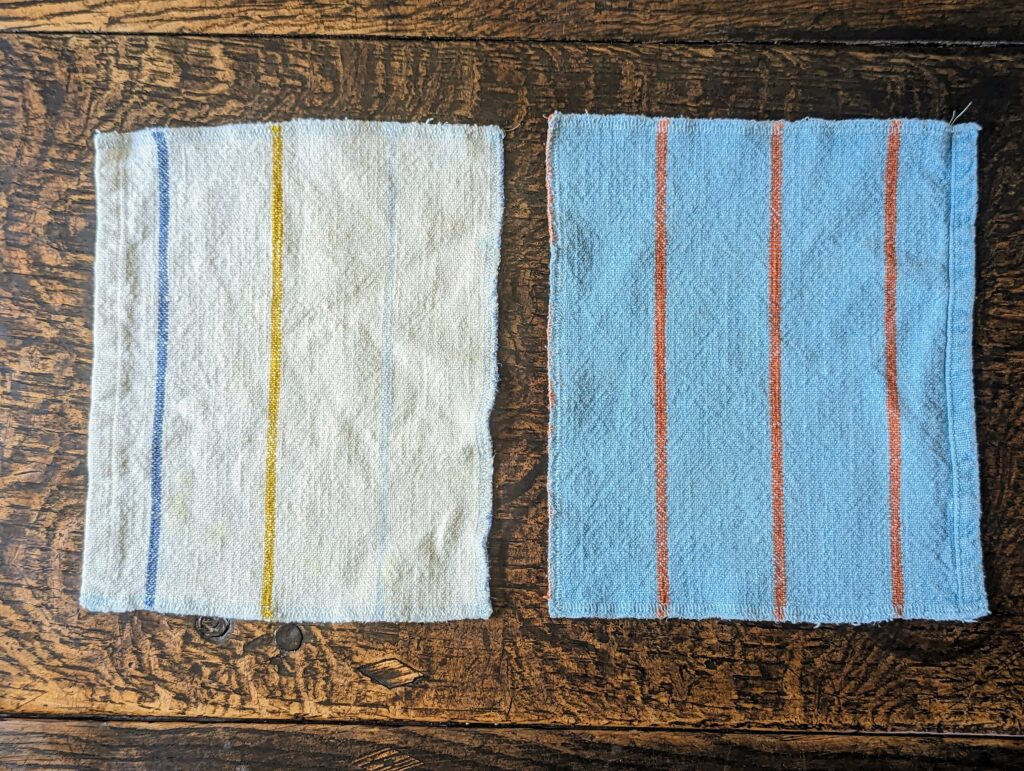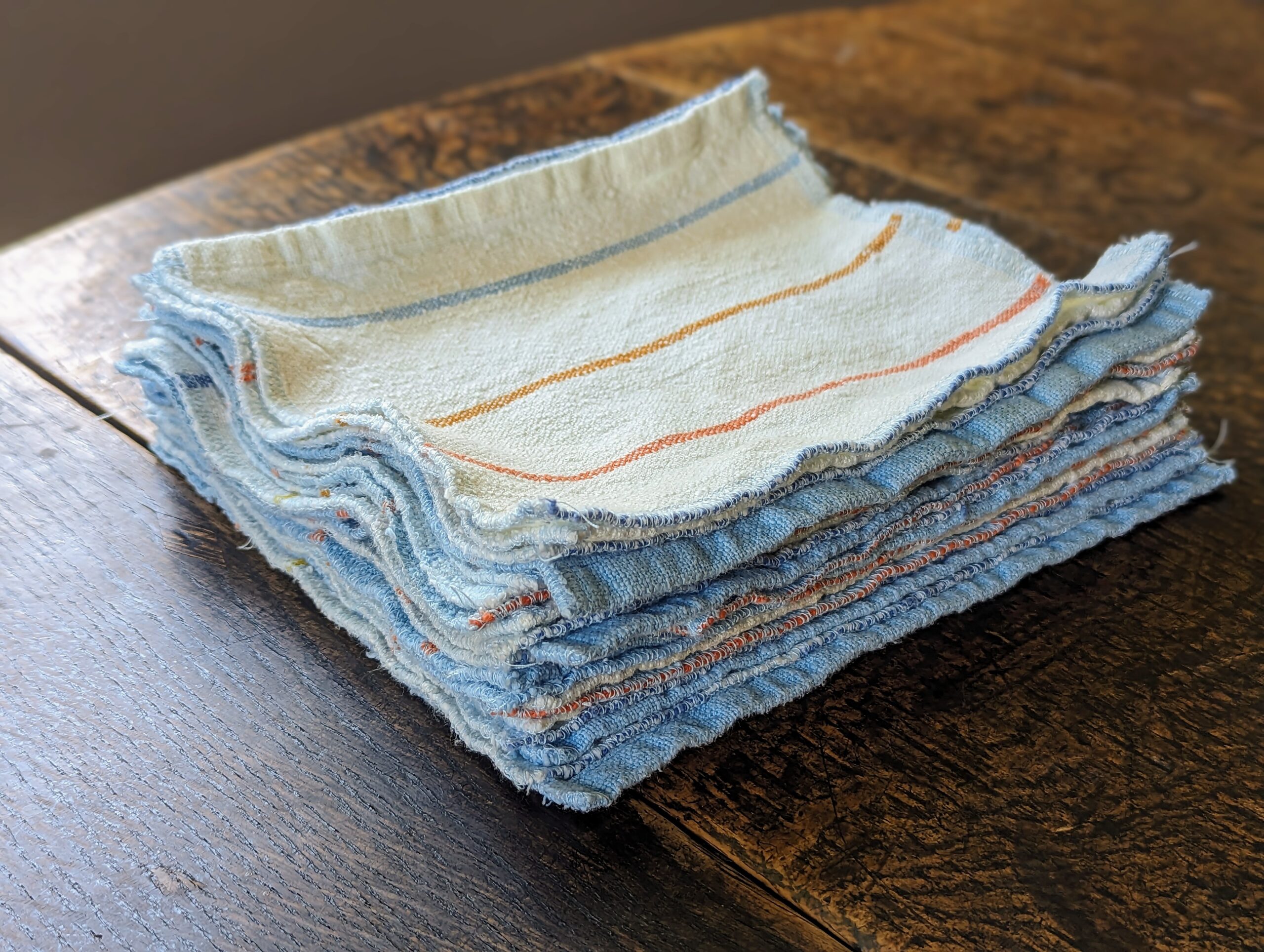
The Idea
A couple months ago, I visited a friend and discovered that she had mostly switched from using paper towels to cloth towels. Staying with her and using her towels convinced me this was an easier switch than I had thought, and by the time I went home I was resolved to switch to non-paper towels myself. Obviously cloth towels are a thing you can buy in stores – and there’s a lot that are specifically aimed at replacing paper towels – but I couldn’t find any exactly like what I wanted, so I ended up making my own.
A quick note on the environmental implications of this project: When it comes to cleaning up kitchen messes, your main choices are paper towels, synthetic towels (like the microfiber cloths my friend uses), or cotton towels (somebody out there probably makes towels out of other natural fibers, but if you’re looking for an absorbent and easily available natural fiber, cotton’s the obvious choice). I wanted to use less paper towels because I’m pretty sure the problems with toilet paper production also apply to paper towels. Reusable towels of any kind will reduce the amount of paper towels used, but I just didn’t like the idea of replacing something biodegradable with something plastic, so I chose cotton over microfiber. Is this actually the best choice? I honestly don’t know. I didn’t have enough information about the manufacturing process of the specific options I was comparing to do any kind of lifecycle emissions comparison. Also, I think that if I tried to optimize every single choice like this, I would end up paralyzed by indecision, and therefore make fewer of these sorts of changes. Instead, when I see an easy opportunity to reduce either waste or emissions, I try to take it, and hope that overall these choices add up to be better for the environment.
Making the towels
For this project, I used a Ruby Star Society cotton toweling fabric that I bought at Portsmouth Fabric Co, a not-quite local fabric store that I like to drop by whenever I’m up that way. I couldn’t choose between the white and blue, so I made about half in each color.
I wanted my towels to be 8” by 10”, and the toweling fabric is 16” wide, so that means I can fit two towels for every 10 inches of fabric. I think I ended up making 24 of each color, so that’s 24 towels x (10 in / 2 towels) = 120 inches, or 3 ⅓ yards for each color. The outside edges of the toweling fabric come pre-hemmed, but you’ll notice that the layout I described doesn’t leave any room for hemming the remaining three edges. That’s because I decided to overlock them instead of hemming them – it was more important to finish them quickly than have a beautiful finish, and I also didn’t want them to be too bulky when they were stacked together.
Luckily, I have a friend who (1) is a better sewer than me; (2) owns a serger/overlocker; and (3) is always willing to help me out with big projects (she helped with my bookshelf covers too). So, I took my fabric over to her house, we cut out the 8” by 10” rectangles, and then she quickly overlocked the edges while I used a darning needle to securely tuck the loose ends in. We did them all with a light blue thread that was a good color match for the blue towels and a nice contrast on the white towels.


Using the towels
We’ve been using these towels for a while now, and I’m very happy with them. We do still have paper towels in the house, but the cotton towels are out on the counter where the paper towels used to be, and the paper towels are tucked away in a cupboard so that we only get them out when we really need them. (For example, we’re still using paper towels to collect food grease, since that’s difficult to wash out of the cotton towels and those paper towels can go in the compost.)
One of my original hesitations with switching from paper towels to fabric towels was that the additional laundry would be a lot of work, but it’s not as bad as I feared. That’s mainly because I don’t actually fold them – I just stack them up neatly and then bend the whole stack and stick it into a basket. It takes way less time than folding each towel, and it’s pretty easy to grab and yank out a single towel when you’re using them. I owe this tip to my friend who originally sold me on cloth towels! It would literally never have occurred to me that something could go through the laundry and not get folded, but when I was helping with her laundry, I asked her how she folded her kitchen towels and she was like “I don’t.”
My other tip about using cloth towels is to make sure you give the wet ones a chance to dry out before tossing them into the laundry basket. I have a laundry basket sitting just outside my kitchen, and when I use these towels, the mostly dry ones go right in the basket but I make sure to hang the more damp ones over the edge of the basket until the next morning. In the morning, I toss all the dry used towels from the day before into the basket, making room for new wet towels along the edge. This means I don’t have to worry about the towels getting gross and moldy before I wash them.
Overall, I think it was a very successful project and I’m glad I did it.
